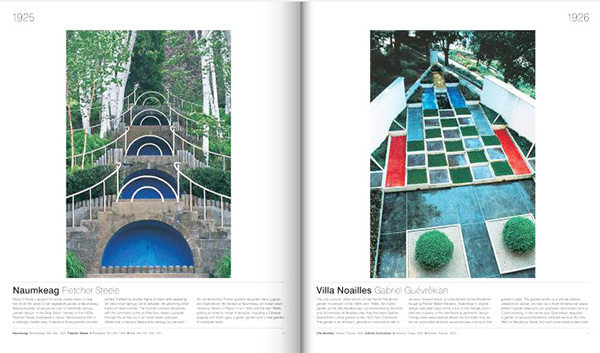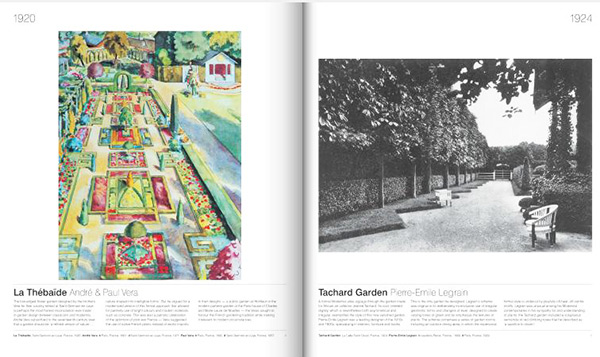From where do we trace the basis of landscape architecture and its evolution? Gardens first started to give us the concept of arranged nature, instilling the idea of designed exterior spaces. By manipulating plants and through artificial construction methods, the idea of the modern garden was pushed forward and landscape architecture got the boost it needed to become what it is today. There are a lot of books out there showcasing examples of contemporary gardens, with an array of visual presentations and textual motivation as to why they stand out. Today, we look at The Contemporary Garden by Phaidon Press Limited, the revised and updated edition published in 2009. Any landscape architect or student should have a basic book on representative gardens. But why choose this one? Get it Here!
The Contemporary Garden sports a detail of Ron Herman’s design of the Ellison Residence on the cover, basically giving the definition of the contemporary garden in a single picture. But what is the definition of the contemporary garden? What this book presents is certainly in no way related to time concepts of our contemporary era on design. Contemporary is presented as the idea of design with innovation and bold use of both plants and artificial constructions, regardless of time. Well-thought content It is Phaidon’s concept of contemporary gardens that allowed them to showcase a diversity of works in this book. You are introduced to approximately 100 gardens from all over the world, built on diverse concepts, all of which can be considered to be contemporary ideas. It’s easy to be inspired by traditional-modern nature gardens like The Gibberd Garden by Sir Frederick Gibberd to modern humanized hybrids like MoMA Courtyard Sculpture Garden by Philip Johnson. Get it Here! What is really great about the content of The Contemporary Garden is that the works are presented in a timeline format, from 1920 to 2008, showcasing not just gardens from the contemporary era, but rather the evolution of the concept of contemporary design and how it manifests itself. This evolution is certainly useful, but it’s not as unitary as you would think, since the gardens presented are very diverse and tap into different cultural, architectural, and local design patterns. You will discover innovative, trademark design from roof gardens like Show Case House by Madison Cox to old-school labyrinth gardens like Tulcán Gardens by José Maria Azael Franco Guerrero. The pros and cons of the book’s layout The Contemporary Garden by Phaidon is a hardback with a sturdy structure and thick pages. It’s a big book and quite heavy, so if you plan to walk it around, it will take some hard work. The format is large so that the color and black-and-white pictures are detailed; however, you will find only one picture per garden, showing a one-sided perspective. A more intriguing layout with multiple pictures would have presented the projects more clearly. The text is very well placed and concise enough to give a clear presentation of the work. The year in which the project was built can be found on all pages in the upper corner of every page. Get it Here! The best argument for getting it? This book offers diversity in design and construction methods, a basis for knowledge in contemporary design of gardens. It’s a must-have in your bookshelf regardless of whether you are a student, a landscape architecture enthusiast, or a professional in the field. The text that accompanies the visual representations of the gardens is very concise, giving you a representative presentation of the work. Basically, it gives you exactly what you need to know in an elegant way. This book is easy to use and quite interesting and useful even for a newbie in the domain. The diversity inspires you and the presentations are clear and provide a basis for gardeners and landscape architects alike. It’s a joy to flick through the pages and to analyze the details. This guide facilitates learning about an ever-changing and enchanting art. About the book and authors: (taken from The Contemporary Garden) “The Contemporary Garden presents 100 seminal gardens from the early 1920s to the present day. Organized chronologically, all types and styles are featured, including roof and water gardens, Modernist landscapes, conceptual installations and urban parks. The Contemporary Garden is an inspiring guide to this ever-changing form.” Text written by Barbara Abbs, Patrick Bowe, Kathryn Bradley-Hole, Anne de Charmant, Aulani Mulford, Toby Musgrave, Jennifer Potter and Tim Richardson. The Contemporary GardenLogin
Lost Password
Register
If this is your first time on the new site, please click "Forgot your password?". Follow the steps to reset your password. It may be the same as your old one.








![Workaround [Video]](https://land8.com/wp-content/uploads/2018/03/richard-jones-land8x8-224x150.png)





